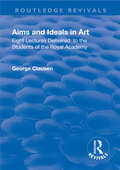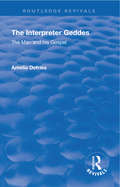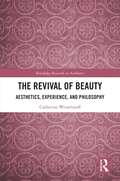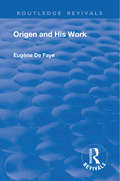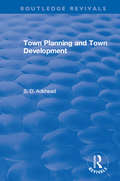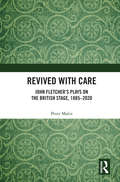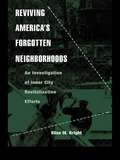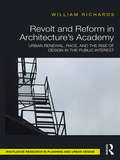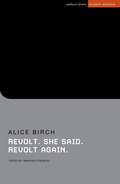- Table View
- List View
Revival: Eight lectures delivered to the students of the Royal Academy (Routledge Revivals)
by George ClausenGeorge Clausen delivers these eight lectures to the students of The Royal Academy of Arts about the aims and ideals of art. He includes the truth to nature and style within art and explores the imagination and taste in drawing and using colour.
Revival: Eight lectures delivered to the students of the Royal Academy (Routledge Revivals)
by George ClausenGeorge Clausen delivers these eight lectures to the students of The Royal Academy of Arts about the aims and ideals of art. He includes the truth to nature and style within art and explores the imagination and taste in drawing and using colour.
Revival: The Man and His Gospel (Routledge Revivals)
by Amelia DefriesFrom Book’s Foreward What so strongly attracted me in Patrick Geddes when I came to know him in India was, not his scientific achievements, but, on the contrary, the rare fact of the fullness of his personality rising far above his science. Whatever subjects he has studies and mastered have become vitally one with his humanity. He has the precision of the scientist and the vision of the prophet; and at the same time, the power of the artist to make his ideas visible through the language of symbols. His love of Man has given him the insight to see the truth of Man, and his imagination to realize in the world the infinite mystery of life and not merely its mechanical aspect.
Revival: The Man and His Gospel (Routledge Revivals)
by Amelia DefriesFrom Book’s Foreward What so strongly attracted me in Patrick Geddes when I came to know him in India was, not his scientific achievements, but, on the contrary, the rare fact of the fullness of his personality rising far above his science. Whatever subjects he has studies and mastered have become vitally one with his humanity. He has the precision of the scientist and the vision of the prophet; and at the same time, the power of the artist to make his ideas visible through the language of symbols. His love of Man has given him the insight to see the truth of Man, and his imagination to realize in the world the infinite mystery of life and not merely its mechanical aspect.
Revival: Being an Account of the Crime of April 27 1796 and of the Trials Which Followed. (Routledge Revivals)
by Charles OmanThe old mystery of the 'Lyons Mail' is of all crime-problems the most complicated and interesting. It is not even yet forgotten, as those will remember who saw the elder and the younger Irving, play the double part of Lesurques and Dubosq-a sort of misreading of the problem of Dr. Jekyll and Mr. Hyde. But the real story is tangled up with all manner of historical persons. The lost money was going to General Bonaparte, then on his first victorious campaign in the Italian Alps: three of the 'Directors' La Revelliere - Lepeaux, Gohier and Merlin dispute in the affair. Madame Tallien - 'Notre Dame de Thermidor' makes a flitting appearance: still more improbably the two famous epicures of the age - Cambaceres and Brillat-Savarin take the chair. Even Talleyrand shows for a moment.
Revival: Being an Account of the Crime of April 27 1796 and of the Trials Which Followed. (Routledge Revivals)
by Charles OmanThe old mystery of the 'Lyons Mail' is of all crime-problems the most complicated and interesting. It is not even yet forgotten, as those will remember who saw the elder and the younger Irving, play the double part of Lesurques and Dubosq-a sort of misreading of the problem of Dr. Jekyll and Mr. Hyde. But the real story is tangled up with all manner of historical persons. The lost money was going to General Bonaparte, then on his first victorious campaign in the Italian Alps: three of the 'Directors' La Revelliere - Lepeaux, Gohier and Merlin dispute in the affair. Madame Tallien - 'Notre Dame de Thermidor' makes a flitting appearance: still more improbably the two famous epicures of the age - Cambaceres and Brillat-Savarin take the chair. Even Talleyrand shows for a moment.
The Revival of Beauty: Aesthetics, Experience, and Philosophy (Routledge Research in Aesthetics)
by Catherine WesselinoffThis book provides original descriptive accounts of two schools of thought in the philosophy of beauty: the 20th-century “Anti-Aesthetic” movement and the 21st-century “Beauty Revival” movement. It also includes a positive defence of beauty as a lived experience extrapolated from Beauty-Revival position.Beauty was traditionally understood in the broadest sense as a notion that engages our sense perception and embraces everything evoked by that perception, including mental products and affective states. This book constructs and places in parallel with one another the Anti-Aesthetic and Beauty-Revival movements. In the author’s view, Anti-Aestheticism is devoted to a decisive negation of beauty—denying its importance as a philosophical notion and its significance as a lived experience. It suggests that beauty is a merely sensual experience, which can be used, at best, as a distraction from justice and, at worst, as an instrument of evil. Alternatively, the Beauty-Revival movement advances arguments for beauty as an experience that extends primarily to sensual experience, but which also calls forth mental products and cognitive and affective states evoked by that experience. After reconstructing these two positions, the author elaborates on the notion of beauty as a lived experience through three key moments which occur in the process of our experiencing beautiful objects. These moments are (a) the conditions that constitute an experience of beauty, (b) the attitudinal features most likely to lead to the experience of beauty, and (c) the results of the experience of beauty.The Revival of Beauty will be of interest to scholars and advanced students working in aesthetics, history of philosophy, and art history.
The Revival of Beauty: Aesthetics, Experience, and Philosophy (Routledge Research in Aesthetics)
by Catherine WesselinoffThis book provides original descriptive accounts of two schools of thought in the philosophy of beauty: the 20th-century “Anti-Aesthetic” movement and the 21st-century “Beauty Revival” movement. It also includes a positive defence of beauty as a lived experience extrapolated from Beauty-Revival position.Beauty was traditionally understood in the broadest sense as a notion that engages our sense perception and embraces everything evoked by that perception, including mental products and affective states. This book constructs and places in parallel with one another the Anti-Aesthetic and Beauty-Revival movements. In the author’s view, Anti-Aestheticism is devoted to a decisive negation of beauty—denying its importance as a philosophical notion and its significance as a lived experience. It suggests that beauty is a merely sensual experience, which can be used, at best, as a distraction from justice and, at worst, as an instrument of evil. Alternatively, the Beauty-Revival movement advances arguments for beauty as an experience that extends primarily to sensual experience, but which also calls forth mental products and cognitive and affective states evoked by that experience. After reconstructing these two positions, the author elaborates on the notion of beauty as a lived experience through three key moments which occur in the process of our experiencing beautiful objects. These moments are (a) the conditions that constitute an experience of beauty, (b) the attitudinal features most likely to lead to the experience of beauty, and (c) the results of the experience of beauty.The Revival of Beauty will be of interest to scholars and advanced students working in aesthetics, history of philosophy, and art history.
Revival: Origen and his Work (Routledge Revivals)
by Eugene de FayeLast year (1925) the Olaus Petri Endowment greatly honoured the author by inviting him to deliver a few lectures on Origen at the University of Upsala. It was agreed that they should be published and we now offer them to the public exactly as they were delievered. There could be no question of expounding the entire thought of Origen in eight conferences. We have been compelled to pass over more than one important doctrine - for instance, his ideas on the Gnosis. Still less was it possible to set forth in these lectures the enormous mass of documents upon which our exposition of the theology of Origen is based.
Revival: Origen and his Work (Routledge Revivals)
by Eugene de FayeLast year (1925) the Olaus Petri Endowment greatly honoured the author by inviting him to deliver a few lectures on Origen at the University of Upsala. It was agreed that they should be published and we now offer them to the public exactly as they were delievered. There could be no question of expounding the entire thought of Origen in eight conferences. We have been compelled to pass over more than one important doctrine - for instance, his ideas on the Gnosis. Still less was it possible to set forth in these lectures the enormous mass of documents upon which our exposition of the theology of Origen is based.
Revival: Town Planning and Town Development (Routledge Revivals)
by S. D. AdsheadSince the passing of the Housing, Town Planning, etc, Act, 1909, there have been published a considerable number of books and a vast number of pamphlets and magazine articles dealing with the subject of Town Planning. There has, however, been produced nothing that can be described as a text-book for the student." A detailed study, including the sociological basis of town planning, traffic requirments & roads, zoning, town planning, municipal planning, and early housing acts, later acts, and more."
Revival: Town Planning and Town Development (Routledge Revivals)
by S. D. AdsheadSince the passing of the Housing, Town Planning, etc, Act, 1909, there have been published a considerable number of books and a vast number of pamphlets and magazine articles dealing with the subject of Town Planning. There has, however, been produced nothing that can be described as a text-book for the student." A detailed study, including the sociological basis of town planning, traffic requirments & roads, zoning, town planning, municipal planning, and early housing acts, later acts, and more."
Revived with Care: John Fletcher’s Plays on the British Stage, 1885–2020
by Peter MalinThis book presents a ground-breaking, comprehensive study of the modern performance history of plays in the John Fletcher canon, excluding his collaborations with Shakespeare. It examines how seventeen of Fletcher’s plays have been interpreted in British productions. In addition, the book offers a consideration of the contexts in which these productions took place, from the early twentieth century ‘Elizabethan Revival’ to the more politicized theatrical cultures of the 1960s and beyond. Revived with Care opens a window on some of the theatrical developments of the past 135 years, in the context of radical changes in the presentation and reception of early modern drama, while for theatre practitioners it provides ideas and inspiration for exploring little-known but powerful plays in exciting new productions. The book will be of great interest to students, scholars and practitioners working in the field of theatre and performance studies.
Revived with Care: John Fletcher’s Plays on the British Stage, 1885–2020
by Peter MalinThis book presents a ground-breaking, comprehensive study of the modern performance history of plays in the John Fletcher canon, excluding his collaborations with Shakespeare. It examines how seventeen of Fletcher’s plays have been interpreted in British productions. In addition, the book offers a consideration of the contexts in which these productions took place, from the early twentieth century ‘Elizabethan Revival’ to the more politicized theatrical cultures of the 1960s and beyond. Revived with Care opens a window on some of the theatrical developments of the past 135 years, in the context of radical changes in the presentation and reception of early modern drama, while for theatre practitioners it provides ideas and inspiration for exploring little-known but powerful plays in exciting new productions. The book will be of great interest to students, scholars and practitioners working in the field of theatre and performance studies.
Reviving America's Forgotten Neighborhoods: An Investigation of Inner City Revitalization Efforts (Contemporary Urban Affairs)
by Elise M. BrightThis book examines both successful and unsuccessful efforts at revitalizing low-income neighborhoods and features case studies on a wide range of American cities.
Reviving America's Forgotten Neighborhoods: An Investigation of Inner City Revitalization Efforts (Contemporary Urban Affairs)
by Elise M. BrightThis book examines both successful and unsuccessful efforts at revitalizing low-income neighborhoods and features case studies on a wide range of American cities.
Reviving Critical Planning Theory: Dealing with Pressure, Neo-liberalism, and Responsibility in Communicative Planning (RTPI Library Series)
by Tore Øivin SagerDiscussing some of the most vexing criticism of communicative planning theory (CPT), this book goes on to suggest how theorists and planners can respond to it. Looking at issues of power, politics and ethics in relation to planning, this book is for both critics and advocates of CPT, with lessons for all. With severe criticisms being raised against CPT, the need has arisen to systematically think through what responsibilities planning theorists might have for the end-uses of their theoretical work. Offering inventive proposals for amending the shortcomings of this widely adhered planning method, this book reflects on what communicative planning theorists and practitioners can and should do differently.
Reviving Critical Planning Theory: Dealing with Pressure, Neo-liberalism, and Responsibility in Communicative Planning (RTPI Library Series)
by Tore Øivin SagerDiscussing some of the most vexing criticism of communicative planning theory (CPT), this book goes on to suggest how theorists and planners can respond to it. Looking at issues of power, politics and ethics in relation to planning, this book is for both critics and advocates of CPT, with lessons for all. With severe criticisms being raised against CPT, the need has arisen to systematically think through what responsibilities planning theorists might have for the end-uses of their theoretical work. Offering inventive proposals for amending the shortcomings of this widely adhered planning method, this book reflects on what communicative planning theorists and practitioners can and should do differently.
Revolt and Reform in Architecture's Academy: Urban Renewal, Race, and the Rise of Design in the Public Interest
by William RichardsRevolt and Reform in Architecture’s Academy uniquely addresses the complicated relationship between architectural education and urban renewal in the 1960s, which paved the way for what is today known as public interest design. Through an examination of curricular reforms at Columbia University’s and Yale University’s schools of architecture in the 1960s, this book translates the "urban crisis" through the experiences of two influential groups of architecture students, as well as their contributions to design’s lexicon. The book argues that urban renewal and campus expansion half a century ago recast architectural education at two schools whose host cities, New York and New Haven, were critical sites for political, social, and urban upheaval in America. The urban challenges of that time are the same challenges rapidly growing cities face today—access, equity, housing, and services. As architects, architects in training, and architecture students continue to wrestle with questions surrounding how design may serve a broadly defined public interest, this book is a timely assessment of the forces that have shaped the debate.
Revolt and Reform in Architecture's Academy: Urban Renewal, Race, and the Rise of Design in the Public Interest
by William RichardsRevolt and Reform in Architecture’s Academy uniquely addresses the complicated relationship between architectural education and urban renewal in the 1960s, which paved the way for what is today known as public interest design. Through an examination of curricular reforms at Columbia University’s and Yale University’s schools of architecture in the 1960s, this book translates the "urban crisis" through the experiences of two influential groups of architecture students, as well as their contributions to design’s lexicon. The book argues that urban renewal and campus expansion half a century ago recast architectural education at two schools whose host cities, New York and New Haven, were critical sites for political, social, and urban upheaval in America. The urban challenges of that time are the same challenges rapidly growing cities face today—access, equity, housing, and services. As architects, architects in training, and architecture students continue to wrestle with questions surrounding how design may serve a broadly defined public interest, this book is a timely assessment of the forces that have shaped the debate.
Revolt. She said. Revolt again (Student Editions)
by Alice BirchThrough a series of arresting vignettes and a collection of nameless characters, Alice Birch examines the language, behaviour and forces that shape women in the 21st century. The play asks what's stopping us from doing something truly radical to change them?Written in response to the provocation that well-behaved women seldom make history, the play is an assault on the language that has fueled violence against women throughout history. Problematic language frequently attached to women is interrogated, from lazy sexist clichés to the conventions around a marriage proposal. Through doing so, the play rails against the conventions of work, sex, motherhood, aging and love. Revolt. She said. Revolt again was first performed at the 2014 Midsummer Mischief Festival in Stratford-upon-Avon. It transferred to the Royal Court Upstairs and was more recently produced at New York's Soho Rep.It is published here in a Student Edition alongside commentary and notes by Marissia Fragkou, who locates the play in our contemporary political and cultural context (including second- and third-wave feminism, and the #MeToo movement).
Revolt. She said. Revolt again (Student Editions)
by Alice BirchThrough a series of arresting vignettes and a collection of nameless characters, Alice Birch examines the language, behaviour and forces that shape women in the 21st century. The play asks what's stopping us from doing something truly radical to change them?Written in response to the provocation that well-behaved women seldom make history, the play is an assault on the language that has fueled violence against women throughout history. Problematic language frequently attached to women is interrogated, from lazy sexist clichés to the conventions around a marriage proposal. Through doing so, the play rails against the conventions of work, sex, motherhood, aging and love. Revolt. She said. Revolt again was first performed at the 2014 Midsummer Mischief Festival in Stratford-upon-Avon. It transferred to the Royal Court Upstairs and was more recently produced at New York's Soho Rep.It is published here in a Student Edition alongside commentary and notes by Marissia Fragkou, who locates the play in our contemporary political and cultural context (including second- and third-wave feminism, and the #MeToo movement).
The Revolting Child in Horror Cinema: Youth Rebellion and Queer Spectatorship
by Andrew ScahillThe monstrous child is the allegorical queer child in various formations of horror cinema: the child with a secret, the child 'possessed' by Otherness, the changeling child, the terrible gang. This book explores the possibilities of 'not growing up' as a model for a queer praxis that confronts the notion of heternormative maturity.
Revolution: Interior Design from 1950
by Drew PlunkettThe last half of the twentieth century saw the emergence, evolution and consolidation of a distinct interior design practice and profession. This book is invaluable for students and practitioners, providing a detailed specialist, contemporary historical analysis of their profession and is beautifully illustrated, with over 200 photos and images from the 1950s through to the present day.
Revolution: Interior Design from 1950
by Drew PlunkettThe last half of the twentieth century saw the emergence, evolution and consolidation of a distinct interior design practice and profession. This book is invaluable for students and practitioners, providing a detailed specialist, contemporary historical analysis of their profession and is beautifully illustrated, with over 200 photos and images from the 1950s through to the present day.
